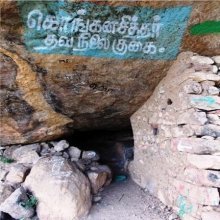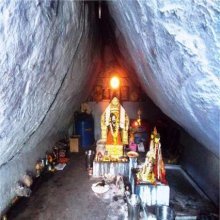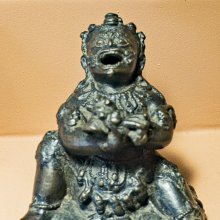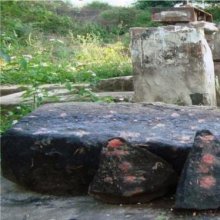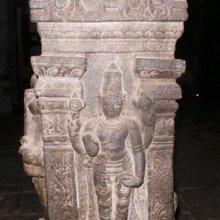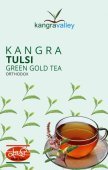Medicine: 6 definitions
Introduction:
Medicine means something in Buddhism, Pali, Hinduism, Sanskrit, the history of ancient India. If you want to know the exact meaning, history, etymology or English translation of this term then check out the descriptions on this page. Add your comment or reference to a book if you want to contribute to this summary article.
Images (photo gallery)
(+7 more images available)
In Hinduism
Ayurveda (science of life)
Toxicology (Study and Treatment of poison)
Source: Shodhganga: Kasyapa Samhita—Text on Visha ChikitsaMedicine refers to one of the topics dealt with in the Kāśyapa Saṃhitā: an ancient Sanskrit text from the Pāñcarātra tradition dealing with both Tantra and Viṣacikitsā—an important topic from Āyurveda which deals with the study of Toxicology (Viṣavidyā or Sarpavidyā).—Vedas, being the fountainhead of all our knowledge and culture, it is but inevitable that Toxicology is also sourced from the Ṛgveda and Atharva veda. [...] Kāśyapa, the author of the Kāśyapasaṃhitā, displays his encyclopaedic knowledge on a battery of topics like Toxicology, Medicine, Botany, Zoology, Astronomy, Astrology, Yoga, Svarodaya, Pharmacology, Herpetology, Opiliatry, Occultism, Mantra Śāstra, Śakuna Śāstra and General Hygiene.
Unclassified Ayurveda definitions
Source: National Mission for Manuscripts: Traditional Medicine System in IndiaAyurvedic medicine are of different types. They can be used as single drugs, i.e. plants, metals and mineral drugs and animal drugs used in a single. It can be used as formulations also, i.e. a herb with a mineral or animal one and vice-versa. Herbo-mineral, herbo-animal and mineral-animal preparations can be used. All the three in combination is also a drug of choice. On this basis the source medicines are mentioned as jaṅgama (animal product) udbhida (herbs) and pārthiva (minerals).
Ayurvedic medicinal preparation and formulation are many in number.
- svarasa: which is the expressed juice of herbs;
- kalka: grounded paste of medicine and when they are dried known as cūrṇa (powder);
- kvātha: peapared kaṣāya;
- yavāgu and yūṣa are juices of dhānya or cereals;
- cold kaṣāya and hot kaṣāya;
- tablets and capsule;
- semi-solid lehya preparation;
- fermented preparation like ariṣṭas;
- mineral drug preparation.
The treatment principle of Āyurveda is addition to the body with same properties as that of doṣas and dhātus when they are of decreased level in the body. Deletion of the defected doṣas and dhātus with opposite properties when they are of excess in body.

Āyurveda (आयुर्वेद, ayurveda) is a branch of Indian science dealing with medicine, herbalism, taxology, anatomy, surgery, alchemy and related topics. Traditional practice of Āyurveda in ancient India dates back to at least the first millenium BC. Literature is commonly written in Sanskrit using various poetic metres.
Purana and Itihasa (epic history)
Source: Shodhganga: Elements of Art and Architecture in the Trtiyakhanda of the VisnudharmottarapuranaMedicine refers to one of the topics dealt with in the Puranic literature: a category of ancient Sanskrit texts which gives a huge contribution in the development of Indian literature.—The Vishnudharmottara Purana contains different aspects of knowledge. Along with the narratives, this work bears immense information in various fields of study. [...] The second khanda comprises 183 adhyayas, where mainly various aspects of Dharma and Rajaniti are nicely discussed. Here, the rules and regulations of four Ashramas viz. Brahmacarya, Garhasthya, Vanaprastha and Sanyasa are elaborately explained. Moreover, a few chapters of this khanda are devoted to Astronomy and Medicine.

The Purana (पुराण, purāṇas) refers to Sanskrit literature preserving ancient India’s vast cultural history, including historical legends, religious ceremonies, various arts and sciences. The eighteen mahapuranas total over 400,000 shlokas (metrical couplets) and date to at least several centuries BCE.
In Buddhism
Tibetan Buddhism (Vajrayana or tantric Buddhism)
Source: Google Books: The Crystal Mirror of Philosophical SystemsMedicine refers to one of the “Ten Sciences” (in Tibetan: rig gnas bcu) which were taught by Śākyaśrī to Sakya Pandita (Sapan).—[...] At the age of twenty-three, Sakya Pandita (1182–1251) met the great Kashmiri pandit Śākyaśrī. With the great pandit and his disciples, Saṅghaśrī, Sugataśrī, and Dānaśīla, he trained completely in the ten sciences [e.g., medicine]. At the age of twenty-seven, he took full ordination from the great Kashmiri pandit.
Source: Rigpa Shedra: WikiMedicine as one of the “Five Major Sciences” (Tibetan: rig gnas chen po lnga) forms part of the “Ten Sciences” (Tibetan: rig gnas bcu), or fields of knowledge. The term “craftsmanship” is known in Sanskrit as Cikitsā and in Tibetan as gso ba.

Tibetan Buddhism includes schools such as Nyingma, Kadampa, Kagyu and Gelug. Their primary canon of literature is divided in two broad categories: The Kangyur, which consists of Buddha’s words, and the Tengyur, which includes commentaries from various sources. Esotericism and tantra techniques (vajrayāna) are collected indepently.
India history and geography
Source: archive.org: Hindu Mathematics (History)Books on the knowledge of Medicine were translated from Sanskrit and transmitted to Arab literature.—The foundations of Arabic literature and science were laid between 750-850 A.D. This was done chiefly with the aid of foreigners and with foreign material. The bulk of their narrative literature came to the Arabs in translation from Persian. Books on the science of war, the knowledge of weapons, the veterinary art, falconry, and the various methods of divination, and some books on medicine were translated from Sanskrit and Persian. They got the exact sciences from Greece and India.

The history of India traces the identification of countries, villages, towns and other regions of India, as well as mythology, zoology, royal dynasties, rulers, tribes, local festivities and traditions and regional languages. Ancient India enjoyed religious freedom and encourages the path of Dharma, a concept common to Buddhism, Hinduism, and Jainism.
See also (Relevant definitions)
Partial matches: Medicine, Te.
Query error!
Full-text (+3877): Aushadha, Ayurveda, Bheshaja, Anupana, Agada, Cikitsa, Bhaishajya, Vaidyaka, Rasayana, Oshadhi, Jayu, Leha, Bhaishajyaguru, Bhaishaja, Vaidya, Anulomana, Pancakarma, Kayacikitsa, Saukarya, Trailokyacintamani.
Relevant text
Search found 427 books and stories containing Medicine, Medicines, The medicine; (plurals include: Medicines, Medicineses, The medicines). You can also click to the full overview containing English textual excerpts. Below are direct links for the most relevant articles:
Bhesajjakkhandhaka (Chapter on Medicine) (by Hin-tak Sik)
Dermatology (a): Itching Lesions < [Chapter 5 - Diseases and Treatments in the Chapter on Medicine]
Internal Medicine (a): Autumnal Disease < [Chapter 5 - Diseases and Treatments in the Chapter on Medicine]
Medicines (d): Flowers (Puṣpa) < [Chapter 4 - Medicinal Substances in the Chapter on Medicine]
Surgery in ancient India (Study) (by P. P. Prathapan)
8. Description of Medicines and Treatment in Ayurveda < [Chapter 1 - Ayurveda and Sanskrit literature]
3. Vedic Medicine < [Chapter 3 - Schools of Surgery in ancient India]
10. Buddhism and Surgery < [Chapter 2 - The concept and practice of Surgery in ancient India]
International Ayurvedic Medical Journal
Post marketing efficacy and safety study of boheco’s sleep (full spectrum hemp leaf extract based ayurvedic proprietary medicine) for the management of sleep and stress < [2022, Issue 08 August]
AYURVEDIC MANAGEMENT OF URTICARIA w.s.r. to SEETAPITTA- A CASE STUDY < [2018, Issue V, May]
Tablet and tableting in ayurveda (vati kalpana)-a review < [2016, Issue VII July]
The Malaysian Journal of Medical Sciences
Measuring Availability and Affordability of Heart Disease Medicines < [v.26(5): 1–158 2019 Sep]
Herbal Medicine Use in Pregnancy: Tumpat District, Kelantan < [v.15(3): 1–84 2008 Jul]
Awareness of Dispensing Separation in Malaysia: A Cross-Sectional Study < [v.28(1): 1–125 2021 Feb]
World Journal of Pharmaceutical Research
Regulatory Overview of Herbal Medicines in India and South Africa < [2017: Volume 6, August issue 8]
Challenges of providing essential medicines in South Africa and Africa. < [2019: Volume 8, August issue 9]
Generic prescriptions and dispensing in indiaproblems and solutions - a study < [2017: Volume 6, August special issue 9]
Social Folk customs of the Sonowal and Thengal Kacharis (by Suravi Gohain Duwarah)
Part 5 - Folk Medicine (among the tribal communities of Assam) < [Chapter 3 - Social folk customs of the Sonowal Kacharis]
Part 5 - Comparison of Folk Medicine (of Assamese tribes) < [Chapter 5 - Similarities and Dissimilarities]
Part 5 - Changes in Folk medicine < [Chapter 6 - Tradition and Change]
Related products
(+861 more products available)
